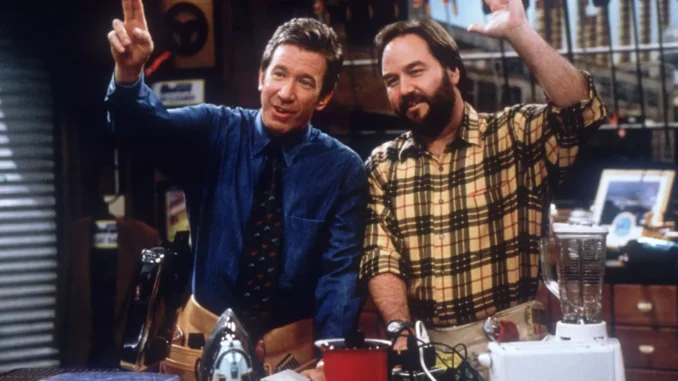
Home Improvement, the hit 1990s sitcom starring Tim Allen as Tim “The Tool Man” Taylor, was beloved for its sharp humor, quirky characters, and memorable moments. As with many sitcoms, much of the humor came from carefully scripted lines, but Tim Allen’s natural comedic timing and the chemistry between the cast also led to some improvisation. So, how much of Home Improvement was improvised?
The Role of Improvisation in Home Improvement
Tim Allen, a stand-up comedian before his acting career, brought a lot of his comedic instincts to Home Improvement. His background in live comedy meant that he was comfortable improvising lines and interacting with the audience in a way that felt spontaneous. While the show had a strong script, there were definitely moments where the actors, particularly Allen, would ad-lib or improvise.
In interviews, Tim Allen has mentioned that Home Improvement often allowed for improvisation in specific situations. For instance, the scenes in Tool Time—the fictional DIY TV show within Home Improvement—often gave Allen a chance to riff on his lines, especially during the “Tim’s Toolbox” segments, where his character would get into bizarre or dangerous situations. These moments were sometimes built on the foundation of the script, but the way Tim delivered his lines or reacted to his surroundings was often spontaneous, creating some of the show’s funniest and most memorable moments.
The Role of the Ensemble Cast
While Tim Allen had the most leeway for improvisation, the rest of the cast also contributed their own improvisational touches. Richard Karn, who played Al Borland, Tim’s mild-mannered co-host on Tool Time, often played the straight man to Allen’s more over-the-top antics. However, Karn’s reactions and delivery were sometimes influenced by the moment, allowing for a natural give-and-take between the two.
Other cast members, like Patricia Richardson (Jill Taylor), Jonathan Taylor Thomas (Randy Taylor), and Zachery Ty Bryan (Brad Taylor), also had moments where they improvised, particularly in family scenes. Richardson, in particular, would sometimes ad-lib lines to make her character more grounded and relatable, adding a touch of realism to their home life.
Behind-the-Scenes Collaboration
The writers and directors of Home Improvement were very much aware of the actors’ talents for improvisation. This collaborative environment allowed the cast to explore different comedic beats. For example, in the early seasons, the writers would often give Tim Allen a general outline of what was supposed to happen in a scene, but he was encouraged to explore different ways to bring the joke to life.
The Tool Time segments were particularly ripe for improvisation because they often involved Tim’s character experimenting with tools or getting into absurd situations. While the sketches had a structure and script, the nature of the “live TV” setting within the show allowed for a bit more freedom to veer off-script and generate laughs in the moment. In fact, Tim Allen himself has mentioned that many of the funniest moments in the Tool Time scenes came from improvisation. His character’s often exaggerated, slapstick behavior was a perfect fit for this type of comedy.
Iconic Improvised Moments
One of the most iconic examples of improvisation on Home Improvement came in the early seasons when Tim Allen introduced his catchphrase, “More power!” It was something that emerged naturally from Allen’s performance and resonated so strongly with audiences that it became a staple of his character. Though the phrase was probably intended to be a part of the script, the way Tim would deliver it, along with his enthusiastic gestures, gave it a life of its own.
Another example of improvisation is the playful banter between Tim and Al during the Tool Time segments. While the lines were scripted, the actors’ ability to improvise reactions—especially Richard Karn’s deadpan delivery—added an extra layer of comedy to their interactions. Their timing, often honed through improvisational moments, helped elevate the show’s humor.
Improvisation and the Show’s Tone
The blend of scripted material with improvisation helped create the warm, authentic tone of Home Improvement. The show was known for its balance between slapstick humor (mostly provided by Tim’s character) and the relatable family dynamics. Improvised moments added a layer of authenticity, making the show feel less rigid and more natural.
Tim Allen’s ability to go off-script without disrupting the flow of the episode allowed Home Improvement to feel fresh and spontaneous, even in its more structured moments. His improvisational flair was one of the key reasons why the show resonated with viewers, making it feel like you were watching a group of people just having fun on-screen, even though everything was still part of a well-crafted sitcom.
A Mixture of Script and Spontaneity
While Home Improvement was definitely scripted, much of its humor came from the actors’ ability to improvise and riff off each other. Tim Allen, with his background in stand-up comedy, had the freedom to add spontaneity to his character, especially during the Tool Time segments. This blend of structure and improvisation helped create the show’s charm, keeping it fresh, funny, and relatable. So, while the majority of Home Improvement was carefully scripted, improvisation played a significant role in making it one of the most beloved sitcoms of the ’90s.
